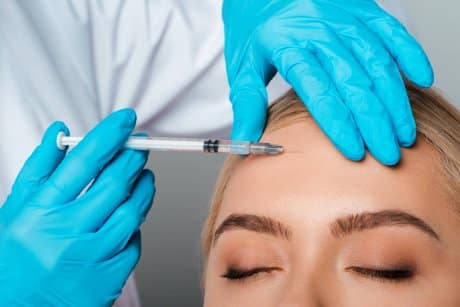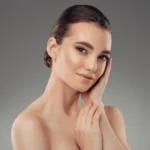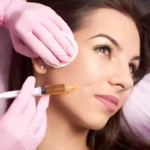

Disclaimer: Botox is manufactured to be used by certified professionals with special training. It can only be sold to licensed aesthetic doctors and special beauty clinics. Independent unprofessional use of Botox could harm your health.
More than a third of all botulinum therapy procedures are injections of Botox or similar drugs into the forehead. Injections in this area are performed more often than in any other part of the face or body simply because wrinkles form here earlier than anywhere else.
With so many factors to consider, including the patient’s age, skin type, and severity of wrinkles, it can be challenging to determine how many units of Botox for the forehead are needed for optimal results. However, choosing the correct dosage is crucial in achieving the desired outcome and avoiding potential complications.
What Is Botulinum Therapy?
Botulinum therapy is an injection procedure with botulinum toxin type A, aimed at reducing the visibility of wrinkles and skin folds, mainly on the face. Botulinum toxin blocks the neuromuscular transmission of nerve impulses and relaxes the muscles that have been injected. This method of correcting age wrinkles and other cosmetic defects is called Beauty Injections.
Injections are a reliable method used for 20 years in cosmetology to eliminate wrinkles and imperfections.
An accurate, immediate result, solving aesthetic and physiological problems that other injection methods cannot correct, a short period of rehabilitation, speed, and painlessness of the procedure are solid arguments for using botulinum therapy in the fight for your patients’ beauty and youth.
The high visibility of these skin folds further enhances the effect. If in some places (for example, in the corners of the eyes) wrinkles are small and visually smoothed out by eyelashes, eyes, and sometimes hair, the forehead occupies most of the face. Any skin defects here are unavoidably noticeable.
For this reason, wrinkles on the forehead often require measures to be taken even earlier than the classic Botox “interbrow area.”
Botox was the first commercially successful botulinum toxin preparation and is still, to this day, the unchanging sales leader among analogs.
Forehead Muscles and Botox
Deformation of the upper part of the face leads to a tired look, and a decrease in elasticity also affects functional capabilities. Changes associated with complex aging – atrophy of the subcutaneous tissue, skin dehydration, and muscle fiber deformation – all lead to the formation of parallel horizontal folds across the entire forehead and vertical wrinkles on the upper part of the nose bridge.
The first wrinkles can be seen before the age of 27-30. After 35, the folds are clearly visible, and the changes lead to a shift in the eyebrow line. By the age of 45-50, deep furrows form on the forehead, and swelling of the eyelids leads to drooping of the outer corners of the eyes.
Let’s take a moment to look into the anatomy of the forehead muscle, also known as the frontalis. It is responsible for unsightly horizontal lines on the forehead, and its primary function is to raise the eyebrows and skin of the forehead while opposing the depressor action of the glabella. It is the only muscle responsible for lifting in the upper third of the face.
However, injecting the forehead without simultaneously treating the frown line muscles can lead to undesirable results. If the ability of the frontalis to lift is taken away without also addressing the depressor action of the glabella, a heavy brow and hooded eyes look can easily result. Therefore, a skilled injector is cautious when treating the forehead to avoid such complications.
Botox, like any other botulinum toxin product, does not directly affect the wrinkles themselves. It does not fill them like fillers, so it does not stretch and smooth the skin (like peelings and reinforcing threads). Instead, the principle of Botox action is different: the drug de-nerves the muscles responsible for contraction wrinkles of the skin, which then form creases on it.
Muscle relaxation occurs due to the main effect of botulinum toxin: it disrupts the transmission of nerve impulses in neuromuscular synapses – places of contact between nerve endings and muscle cells.
Here, in the synapses, the incoming nerve impulse stimulates the release of acetylcholine, which causes the muscle fiber to contract. When botulinum toxin enters the synapse, acetylcholine ceases to be released, and the muscle does not contract, regardless of the neurons’ activity.
After the Botox injection, the forehead does NOT wrinkle during involuntary muscle contractions or even when someone tries to do it on purpose. Some unwanted effects of botulinum therapy are related to this, which will be overviewed below.
Factors Influencing Botox Dosage
Several factors influence how many units of Botox you will need to use for the forehead. Still, ultimately it boils down to the size and strength of the muscles being the most crucial.
The dosage is calculated taking into account the body’s characteristics and the skin’s type and condition: thin and dry skin requires less product than oily, and women need less than men.
Other factors influencing Botox dosage are the following:
• Sex (men tend to require more units);
• Cosmetic goals (the ultra-smooth look requires more Botox than just maintaining a complete range of facial movement);
• Metabolism (the faster it is, the more units you need to use).
Personalized Dosage Determination
A consultation must precede the Botox procedure. Ask your patient about their illnesses, intolerance to injections, allergies, and skin features: feature susceptibility to couperosis, hyperpigmentation, and scarring. During the examination, ask the patient to frown and raise eyebrows. Take pictures of the face in a frowning and relaxed state.
The average cost of Botox for the forehead varies from patient to patient, depending on how many units of the product they will need.
The muscles that cause the formation of forehead wrinkles are usually strong and can vary in length; the optimal dose may differ from person to person. While 20-units may be adequate for many people, those with longer and stronger muscles may require a higher dosage for optimal results, up to 40–50 units.
Under-dosing a muscle not only leads to unsatisfactory results but also reduces the longevity of the treatment, which should ideally last for 3–4 months. Inadequate dosing in the frown lines can also cause the muscles to remain active, leading to noticeable bulges at the muscles’ ends, which is undesirable.
Recommended Dosage Range for Forehead Botox
All drugs containing botulinum toxin are labeled with the number of units.
Unit is an amount of botulinum toxin presented in the product, not the total amount of liquid in a vial. Units of Botox aren’t equal to units of its analogs.
Why counting in units is essential? They help to understand how much active ingredient is injected in the area. Navigating by milliliters is not convenient because bottles are produced in different volumes.
Allergan has general recommendations on how much Botox for the forehead is needed: 4 Units (0.1 ml) of reconstituted Botox into each of 5 sites in the frontalis muscle intramuscularly for a total dose of 20 Units. Forehead lines should be treated in conjunction with glabellar lines (20 Units), so it is 40 Units for the whole procedure.
Post-Injection Recovery and Efficacy
After botulinum therapy, the patient must avoid touching the injection sites, kneading or massaging the area, or applying decorative cosmetics. To consolidate the effect and prevent unwanted consequences, it is also necessary to:
• 4 hours – stay in a vertical position;
• 24 hours – not sleep face down;
• 14–15 days – refrain from visiting saunas, swimming pools and taking hot baths;
• Two weeks – avoid face massage;
• Seven days – not consume alcoholic beverages.
Common Side Effects
If the injection is done correctly and with the proper dosage, there should be no complications. But individual reactions can arise.
The most common complications include hematomas, drooping eyebrows, and swelling. The reason may be due to incorrectly chosen injection points, an incorrect number of Botox units for the forehead, and failure to follow the doctor’s recommendations after the procedure.
Also, the patient may temporarily experience dizziness, headache, and general malaise, which usually passes within a few days. An allergic reaction may also occur.
With an overdose of the drug, the patient may experience facial asymmetry associated with uneven muscle numbness.
When a large dose is administered, it could lead to anaphylactic shock.
Timeline for Onset and Duration of Efficacy
In general, patients can see the effects of Botox in 3 to 4 days after injection. Most Botox therapy patients will see results within 10 to 14 days. Still, they should wait two weeks for maximum results; the effect lasts 3–6 months after treatment.
To determine how long the effect of injected Botox for forehead wrinkles will last, the medical professional must study the patient’s lifestyle – do they play sports, go to the sauna, how old they are, do they have an intensive metabolism, and so on.
The effect won’t last as long if all these factors are present. However, the result will last slightly longer for older patients – with a less active metabolism and neuromuscular transmission, which slowly recovers.
Tips for Optimizing Forehead Botox Treatment Outcomes and Minimizing Adverse Effects
To optimize Botox’s effect, recommend the following to your patients:
• Avoiding sun damage;
• Low-intensity workouts;
• Reducing stress levels;
• Moisturizing skin;
• Avoiding nicotine;
• Taking a Zinc supplement.
Similar Products to Consider
The second most popular product is Dysport. One unit is about 2.5 times weaker than one unit of Botox but also simultaneously cheaper. So, the cost of regular treatment of these toxins is the same for the patient. Xeomin, Neuronox, and other products are identical in effect to Botox, but each has its peculiarities.
For example, botulinum toxin from Xeomin is cleaner and safer but also more expensive. Therefore, when choosing a specific drug, the cosmetologist evaluates its properties and the specifics of a particular patient and uses the product that will be most effective at maximum safety.
Conclusion
So, we know that the standard dosage of Botox for the forehead is 20 units. Still, this procedure can require 10 to 50 units depending on the severity of your patient’s wrinkles and other factors.
It is essential to remember that some patients fall outside the general parameters of standard Botox dosing. Therefore, preparing individualized treatment plans and proper dosing is crucial in Botox treatment.
FAQ
How long does Botox last on the forehead?
Injections of Botox in the forehead last for approximately four months.
The traditional Botox schedule to treat the forehead calls for new injections every 3–4 months. But studies show that less frequent Botox injections can achieve a good result after two years of treatment.
Are 20 units of Botox enough for the forehead?
Allergan suggests the following dosage of forehead Botox injections: 4 units each in five sites on the forehead, totaling 20 units.
References
1. Swift A, Green JB, Hernandez CA, Aguilera SB, Fagien S, Gold MH, Casabona G, Frank K, Nikolis A, Cotofana S. Tips and Tricks for Facial Toxin Injections with Illustrated Anatomy. Plast Reconstr Surg. 2022 Feb 1;149(2):303e-312e. doi: 10.1097/PRS.0000000000008708. PMID: 35077430.
2. Abramo AC. Muscle Insertion and Strength of the Muscle Contraction as Guidelines to Enhance Duration of the Botulinum Toxin Effect in the Upper Face. Aesthetic Plast Surg. 2018 Oct;42(5):1379-1387. doi: 10.1007/s00266-018-1157-3. Epub 2018 Jul 9. PMID: 29987485.
3. Abramo AC, Do Amaral TP, Lessio BP, De Lima GA. Anatomy of Forehead, Glabellar, Nasal and Orbital Muscles, and Their Correlation with Distinctive Patterns of Skin Lines on the Upper Third of the Face: Reviewing Concepts. Aesthetic Plast Surg. 2016 Dec;40(6):962-971. doi: 10.1007/s00266-016-0712-z. Epub 2016 Oct 14. PMID: 27743084.
4. Min P, Zhang Z, Grassetti L, Perdanasari AT, Torresetti M, Pu Z, Zhang Y, Han S, Marsili R, Zhang YX, di Benedetto G, Lazzeri D. Alteration of Skin Mechanical Properties in Patients Undergoing Botulinum Toxin Type A Injections of Forehead Rhytides. Aesthetic Plast Surg. 2016 Jun;40(3):410-20. doi: 10.1007/s00266-016-0629-6. Epub 2016 Mar 4. PMID: 26944891.
5. Jia Z, Lu H, Yang X, Jin X, Wu R, Zhao J, Chen L, Qi Z. Adverse Events of Botulinum Toxin Type A in Facial Rejuvenation: A Systematic Review and Meta-Analysis. Aesthetic Plast Surg. 2016 Oct;40(5):769-77. doi: 10.1007/s00266-016-0682-1. Epub 2016 Aug 5. PMID: 27495260.
*Disclaimer: The contents of this article are not to be constructed as medical advice but for informational purposes only. MedicaDepot staff does not review any of these articles for medical validity. Opinions and views expressed in this article are not endorsed by MedicaDepot. Please always consult your doctor for professional medical advice.
Aesthetic products generally refer to a broad category of items designed to enhance or improve one's appearance, often focusing on skincare, beauty, and personal grooming. These products are typically used to maintain or enhance physical attractiveness and may include a wide range of items intended for both professional and personal use. Here are some common types of aesthetic products:
-
Skincare Products: Including cleansers, moisturizers, serums, and treatments designed to address various skin concerns such as acne, aging, hyperpigmentation, and sensitivity.
-
Cosmetics: Makeup products such as foundations, concealers, eyeliners, lipsticks, and eyeshadows used to enhance facial features and achieve desired looks.
-
Hair Care Products: Shampoos, conditioners, styling products, and treatments to maintain and improve the health and appearance of hair.
-
Fragrances: Perfumes and colognes used to enhance personal scent and attractiveness.
-
Dental Care Products: Toothpaste, mouthwash, whitening treatments, and dental floss aimed at maintaining oral hygiene and enhancing smile aesthetics.
-
Personal Grooming Tools: Including razors, electric shavers, trimmers, and grooming kits used for hair removal and personal hygiene.
-
Beauty Devices: Devices such as facial cleansing brushes, LED light therapy masks, and microcurrent devices designed for at-home skincare treatments.
-
Nutritional Supplements: Supplements aimed at promoting skin health, hair growth, and overall well-being, often containing vitamins, minerals, and antioxidants.




